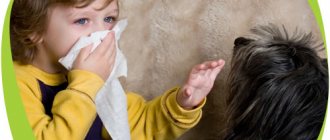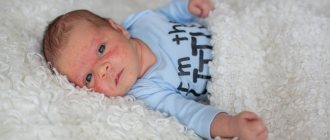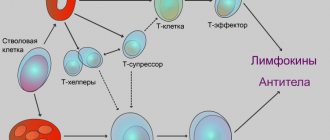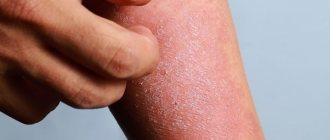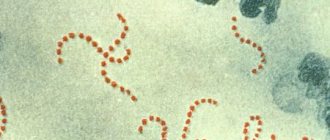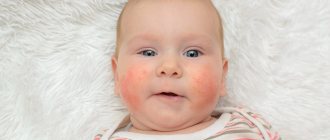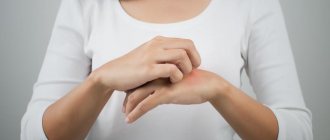Atopic dermatitis is a chronic skin disease. Due to disruption of biochemical processes, excessive dryness, peeling, redness occurs, inflammatory processes develop, and itching is felt. It develops under the influence of allergens, and is often combined with bronchial asthma, food allergies, and allergic rhinitis. It appears in the first years of life, most often before 12 months or at the age of 2-3 years, when the children's diet expands and many allergenic foods enter it. With proper treatment and care, the disease enters the stage of stable, long-term remission, but can manifest itself in adolescents, young and elderly people during contact with allergens, a weakened immune system, and after stress.
Symptoms
With atopic dermatitis in children, skin tightness, redness appears, the skin flakes, feels rougher to the touch, and thickening may appear. Microscopic bubbles form, around which moisture is released. The child is worried and scratches the affected areas. When an infection occurs, local inflammation develops and the wounds heal poorly. With significant spread in young children, general intoxication of the body manifests itself: the temperature rises, the peripheral lymph nodes enlarge. Due to severe itching, sleep and appetite are disrupted, and the child often cries. Dermatitis most often affects the face, neck, armpits, scalp, groin, areas under the earlobes, popliteal fossae, and elbows.
What does diaper rash on the neck look like?
- Initially, the mother notes slight redness in the area of the natural folds of the baby’s neck, which does not bother the child at all.
- Then the skin undergoes visible changes - the mother already notices the appearance of microcracks, small erosions, sometimes pimples and even pustules. Usually this condition bothers the baby with mild itching and burning, which can manifest as tearfulness and poor sleep.
- In severe cases, cracks, erosions and ulcers appear at the sites of diaper rash, and areas with detachment of the epidermis can also be seen. In this situation, a bacterial or fungal infection often occurs, and then a banal diaper rash looks very scary. In addition, the addition of a secondary infection is accompanied by an increase in body temperature, decreased appetite and other general symptoms.
But I hasten to reassure you - a severe form of diaper rash in the neck area is extremely rare, because parents most often notice changes in the skin in time and take certain measures.
It is worth noting that the skin of a newborn is one of the most vulnerable organs. The epidermis in children is loose and thin; the top layer cannot fully perform protective and barrier functions, so penetration of allergens and microorganisms occurs quite easily. Also, the skin is susceptible to easy injury, even with minimal mechanical stress (such as swaddling, bathing, rubbing clothes and diapers) and is prone to weeping. It is for this reason that the skin of babies needs special care and protection from the first days of life, otherwise the appearance of diaper rash in a child is inevitable.
Prevention
Atopy is translated from Latin as strangeness. The causes of the disease cannot always be determined. But long-term observation of patients and members of their families has revealed that it develops more often:
- with a genetic predisposition - if the parents are healthy, the probability of developing dermatitis in the child is 20%, if one of them is sick - 50%, if both are sick - 80%;
- in case of unfavorable pregnancy, active or passive smoking of the expectant mother, consumption of food that provokes allergy attacks, use of certain medications;
- when a newborn is in a dusty room, insufficient care for his personal hygiene;
- with prolonged exposure to allergens that enter the child’s body with food through the respiratory tract.
Breastfeeding for up to 6 months and avoiding allergy-provoking foods reduces the likelihood of developing atopic dermatitis.
What to feed a child with atopic dermatitis
In order not to provoke an exacerbation of dermatitis, to relieve itching and redness of the skin, you need to follow a diet. Foods that burden the immune system are excluded from the children's diet: citrus fruits, chocolate, eggs, honey, seafood. Red (strawberries, cherries, currants, apples) and exotic (mangoes, coconuts, pineapples) fruits are dangerous.
Split meals are recommended: small portions every 3-4 hours. It is better to boil, stew, bake, but not fry. Do not use spices, black pepper. The diet should be balanced and contain enough protein, vitamins, and microelements.
Avoid giving your child sugary carbonated drinks, chips, crackers and other snacks for as long as possible. If the infant is receiving breast milk, introduce new foods carefully. Add the product once a week to make sure it doesn't cause breakouts. After meals and between meals, offer your baby clean boiled water.
Besides this reason, why else does a newborn’s skin peel?
The skin of a baby is very delicate and thin. With the help of peeling, it can indicate a variety of problems - from uncomfortable external conditions that are easy to eliminate, to serious diseases that require competent treatment. We will tell you about the most common problems, but if you have any doubts, we recommend that you consult a doctor.
- Diapers
If ordinary clothing should simply not cause skin problems, diapers must also ensure that these problems do not arise from contact with secretions. Buy only high-quality diapers for newborns and change them at least every 3-4 hours.
Do not forget that even the best diaper will not be able to ensure the absence of flaking and redness if hygiene rules are not followed. When changing a diaper, thoroughly dry the baby's skin, lubricate the folds and let the baby's body breathe for a few minutes.
- Dry air
It is not easy for a baby’s skin to get used to the air, so it is necessary to maintain high humidity in the children’s room - about 50–70%. Buy a hygrometer (a device that measures air humidity) or a weather station with this function. If the device readings are constantly below the recommended level, install a humidifier in the child's room. You can also use traditional methods - wet towels on the radiator, basins of water near the crib, frequent wet cleaning. But with a special device, of course, it is much more convenient: you only need to periodically add water to it, the humidifier will do the rest itself.
Dry air also dries out the mucous membranes of the nose, which can cause breathing and sleep disturbances.
Our expert Polina Vasilyeva
dermatologist
Children's skin contains a large amount of moisture, many times more than that of an adult, but due to a number of physiological characteristics it loses water very easily. Drying out is fraught with the development of various dermatological problems. The baby's skin begins to peel off and becomes very sensitive to various external factors - high and low temperatures, dust, mechanical damage, sunlight and others. - Hygiene products
Some parents take their baby's hygiene very seriously. They buy various gels, shampoos, children's bubble baths and many other bathing products. All later, when the child grows up! At a tender age, these products do not help hygiene, but on the contrary, they can destroy the already fragile natural protection of the skin.
The baby should be bathed in regular tap water. Use shampoo and baby soap no more than once a week, and avoid all other products altogether. Do not add potassium permanganate to the bath - it dries it out and only aggravates the peeling problem.
Our expert Polina Vasilyeva
dermatologist
The child needs to select products specially designed for children’s skin with a good composition (without parabens, sodium lauryl sulfate, fragrances, etc.). - Improper care
The main task of caring for a child's skin is to ensure its hydration. For this, only two products are used - baby cream and baby oil; nothing else should be used. Don’t forget to thoroughly lubricate all the folds on the baby’s body, paying special attention to areas of peeling. And, of course, buy products only from reliable manufacturers and only in reputable stores.
It’s not common, but there are situations when some children’s cosmetics are not suitable for the child. When treating the baby’s skin, parents notice that the problems do not go away or even get worse. In such cases, it is recommended to change the product; in particular, you can try natural “edible” oils - olive, coconut, sesame and others.
Our expert Polina Vasilyeva
dermatologist
To moisturize the skin, it is important to ensure that the baby consumes a sufficient amount of fluid, especially if the body is actively losing it. For example, if a child experiences an intestinal disorder accompanied by vomiting, or has excessive sweating. - Wind, cold, sunlight
Does it ever happen that your face becomes chapped? Have you ever been sunburned? How does your skin feel after a long walk in the cold? Now imagine how all this affects the baby’s skin, which is several times thinner!
To prevent peeling in a newborn, protect exposed parts of his body from wind and direct sunlight. Try not to walk with him in open, windy spaces, choose a shady side of the street, use the stroller hood to protect the baby's skin. Before you start getting your baby ready for a walk in winter, lubricate his face with oil or a special cream. On sunny days, it is recommended to use sunscreen. Make sure the product is absorbed before going outside.
- Food allergies
If a baby's skin is peeling, this may be a manifestation of internal problems in the body, the most common of which is food allergies. At the complementary feeding stage, it is very important to follow the rule of sequential introduction of foods. After you have introduced the baby to a new taste, you need to wait a few days until the next menu expansion and observe possible negative reactions of the body. If you notice that your baby's skin is flaking more than before, it's most likely a new product.
If your baby is currently eating only mother's milk, carefully monitor your diet. Some allergens are able to pass through all the barriers of a woman’s digestive system and enter the milk, and from there into the baby’s body. Is your baby's skin peeling and the situation has suddenly gotten worse? Think about whether you've been on a diet lately.
Our expert Polina Vasilyeva
dermatologist
If the skin dries out due to an allergic reaction, the use of antihistamines is necessary (the specific drug is determined by the doctor). Parents need to ensure that the child does not have contact with the most common allergens - animal hair, dust, pollen, various chemicals, and also temporarily exclude allergenic foods from the diet. - Poor quality clothes
The baby's body is in contact with clothing almost all the time, and this can also be a source of the problem. Artificial fabrics, additives that give the material elasticity, durability and other properties, dyes - all this may not be liked by the skin of a newborn and may result in peeling.
It is advisable that all clothing that directly touches the baby’s body be natural. Buy it only in trusted stores - this guarantees the availability of the necessary hygiene certificates. And learn to confidently refuse an offer from your handicraft grandmother to sew a wonderful overall for your child from your old skirt.
- Detergents
Sometimes there are no harmful substances in the clothes themselves, but they come into them from washing powder, rinse aid, and stain remover. In this case, the baby's skin peels off all of his clothes at once.
If you notice that your problems have gotten worse and you've just recently switched to a new laundry detergent, don't use it anymore. And when buying in a store, choose products that say they are hypoallergenic and suitable for washing children's clothes.
Our expert Polina Vasilyeva
dermatologist
If peeling has already occurred, it is recommended, first of all, to recognize the real cause of its occurrence. If you suspect that peeling could have been caused by household chemicals or personal hygiene products, you need to replace them or eliminate them altogether. - Diapers
If ordinary clothing should simply not cause skin problems, diapers must also ensure that these problems do not arise from contact with secretions. Buy only high-quality diapers for newborns and change them at least every 3-4 hours.
Do not forget that even the best diaper will not be able to ensure the absence of flaking and redness if hygiene rules are not followed. When changing a diaper, thoroughly dry the baby's skin, lubricate the folds and let the baby's body breathe for a few minutes.
- Dry air
It is not easy for a baby’s skin to get used to the air, so it is necessary to maintain high humidity in the children’s room - about 50–70%. Buy a hygrometer (a device that measures air humidity) or a weather station with this function. If the device readings are constantly below the recommended level, install a humidifier in the child's room. You can also use traditional methods - wet towels on the radiator, basins of water near the crib, frequent wet cleaning. But with a special device, of course, it is much more convenient: you only need to periodically add water to it, the humidifier will do the rest itself.
Dry air also dries out the mucous membranes of the nose, which can cause breathing and sleep disturbances.
Our expert Polina Vasilyeva
dermatologist
Children's skin contains a large amount of moisture, many times more than that of an adult, but due to a number of physiological characteristics it loses water very easily. Drying out is fraught with the development of various dermatological problems. The baby's skin begins to peel off and becomes very sensitive to various external factors - high and low temperatures, dust, mechanical damage, sunlight and others.
Skin care
To relieve itching and prevent infection of the affected skin, you need to properly care for your skin:
- It’s better not to take a shower, but to take a cool bath for about 10 minutes; use medicated bathing products with a soft base that cleanse but do not dry the skin;
- moisturizing and softening – the skin should not be dry to prevent flaking and cracking; regularly apply a moisturizer recommended by a dermatologist;
- Do not let your child scratch the affected areas to avoid infection - apply anti-itching products to the atopic areas.
Cream or gel relieves discomfort during an exacerbation and allows you to sleep, eat, and play peacefully. Apply the drug to cleansed skin, treat atopic lesions and the areas around them. Do not exceed the recommended dosage and frequency of use.
Does it often happen that a baby's skin peels?
Let's put it this way: if you find a baby whose skin has never peeled off in the first year of life, you will surprise not only us, but, perhaps, all pediatricians in the world. In most cases, peeling is a completely natural process that is associated with a sharp change in environmental conditions. Sometimes the baby’s skin even peels off; especially problem areas for a newborn are the feet, hands, and head.
Just think about it: over the previous nine months, the child has never encountered a situation where the temperature around him differs from his own. His skin was constantly moisturized and never came into contact with air. Finally, she did not know sunlight and was not exposed to ultraviolet radiation for a second. Now you can imagine the mess your beloved baby got into when he decided to be born 
Typically, a baby's skin will peel because it needs time to adapt to life outside the womb. But there are other factors that lead to this problem.
| Our expert Polina Vasilyeva dermatologist |
| If a newborn's skin peels, this is a physiological phenomenon and is normal. This condition can occur about a day after the birth of the baby and lasts for 3–4 weeks. Despite the fact that this condition is considered normal, it is worth seeing a doctor to rule out congenital ichthyosis and other skin diseases. |
Rating of the best remedies for atopic dermatitis
To treat atopic dermatitis, use special children's products recommended by a dermatologist. During exacerbations, medications are prescribed for oral administration, application to atopic areas and general body care:
- preparations for removing allergens from the body - Enterosgel, Lactrofiltrum, Enterodes;
- skin softening products – Atopic cream for daily care;
- drugs that relieve itching - Panthenol spray;
- bathing products - soft shower gels for atopic dermatitis should be purchased at the pharmacy: dermatologists recommend using Atopic bathing gel from head to toe.
Bathing
After a light shower to thoroughly cleanse your entire body, apply Atopic Bathing Gel to damp skin from head to toe, massage lightly and rinse thoroughly. Dry your baby with a soft towel using blotting, but not rubbing, movements. After water treatments, apply Atopic skin softening cream for daily care. Apply it several times throughout the day: after washing your hands and washing your face.
When taking a bath, the water temperature should not exceed 36 degrees. Place your child in the water and offer him toys or other entertainment. After 5-7 minutes, apply Atopic Bathing Gel from head to toe and rinse well. After bathing, use Atopic cream for daily care, and if itching bothers you, let the cream absorb, and then treat the affected skin with an anti-itching drug.
Urticaria and food allergies in infants
26.05.2021
Urticaria in a child manifests itself as itching, redness, and blisters. It is not uncommon, but in some cases it can be dangerous. One of the symptoms of hives may be a food allergy . Its presence requires certain changes in the diet of the baby, and often his mother. What to do if you suspect a food allergy in a child and how to recognize its symptoms?
Urticaria in a child
The name "urticaria" is no coincidence, because the changes caused by it are similar to those that can be observed as a result of skin contact with nettles. Red, itchy blisters may appear in different places on the body, changing their location over the following days. Urticaria in a child is equivalent to an allergy . One of the most common is food allergies , but children, like adults, can be allergic to dusty plants, animal dander, and dust. Babies' skin is also often irritated by the use of cosmetics or washing powders.
There are several types of urticaria . Acute urticaria in a child appears on the skin as a result of a specific reason and lasts from several days to 1.5 months. Blisters on the skin can persist for more than 6 weeks. urticaria occurs . In idiopathic urticaria, the cause of the disease is unknown, which makes the treatment of skin lesions difficult.
Urticaria in a child can be dangerous if it is accompanied by swelling and rashes around the throat . It can even lead to suffocation. It is worth knowing that the cause of urticaria is not only an allergy , but also a reaction to low or high temperature, exposure to solar radiation, under pressure, as a side effect of medications.
Food allergies in infants
The hives described above are one of the symptoms of food allergies , which can be associated with digestive and breathing problems. Usually this:
- colic;
- flatulence;
- diarrhea;
- constipation;
- cough;
- juice.
Food allergies in an infant often occur when new foods are added to their diet, but can also appear in the first months of life. It is believed that the safest way to prevent allergies is to breastfeed your baby for the first six months of his life. However, it is worth noting that food allergies in a newborn can also arise as a result of foods consumed by the mother. The most common allergens include: cow's milk, eggs, grain products containing gluten, nuts, fruits such as strawberries, bananas or citrus fruits, fish and seafood.
An elimination diet is quite simple to implement when parents introduce new foods into their child's diet one at a time. Then careful observation is enough to determine the causes of food allergies . For the same reason, breastfeeding women should pay close attention to their diet and closely monitor their baby's reactions. In case of milk allergy The tendency to allergies is not always hereditary, but its presence in parents increases the likelihood of allergic reactions in the child.
Treatment of food allergies in infants
In the case of food allergies, the procedure seems clear - just avoid the factor that provokes an abnormal reaction of the immune system . However, if it is impossible to eliminate the allergenic factor, antihistamines are used. Their task is to suppress the secretion of histamine, a substance responsible for the occurrence of hypersensitivity reactions. The same treatment is used for allergic urticaria . For other types of urticaria , it is essential to make an appropriate diagnosis, which then determines treatment or specific preventive measures. Blood tests help determine the causes of hives .
Published in Allergology Premium Clinic
How to choose products that are right for your child
A dermatologist may recommend not one, but several drugs to choose from. They have a similar mechanism of action, but their prices may differ significantly. It depends on the active and auxiliary substances, manufacturer, and release form. When choosing a cream for a child’s atopic skin, you need to take into account possible individual intolerance to individual components.
You need to purchase drugs from well-known manufacturers with a good reputation: Russian, European, American. It is equally important to contact large pharmacy chains that work directly with manufacturers and control the quality of drugs on sale - this will protect you from purchasing counterfeit drugs. Consider the age of the child: choose creams and gels with a pleasant smell so that the child enjoys going to the shower.v
When choosing drugs for oral administration, it is preferable to buy syrups, powders, drops, rather than tablets and capsules that are difficult for a child to swallow.
Should I see a doctor if my newborn's skin is peeling?
In this situation, you need to act the same way as in all others related to the baby’s health: it’s better to play it safe and go to the doctor one more time than to ignore your doubts and start a problem. In addition, there are several alarming symptoms that clearly indicate the need to consult a specialist:
- The baby is growing, but the peeling is not getting smaller.
- The skin began to peel unevenly, and one or more spots appeared on the baby’s body, where the problem manifested itself more acutely.
- The peeling increased sharply, especially if you did not introduce new foods into complementary foods, did not put new clothes on the baby, or changed anything in his life.
- Not only does the baby's skin peel, but there are also other symptoms of skin diseases - red spots or dots, itching, pimples, blisters and others.
| Our expert Polina Vasilyeva dermatologist |
| Initially, the skin of babies is practically never dry due to its saturation with lipids. But they dissolve under the influence of chemicals (which are found in washing powder, soap, and urine), so peeling and inflammation of the skin in babies is quite common. Dry skin can also become due to health problems, and therefore, if there is severe peeling, be sure to consult a doctor. |

